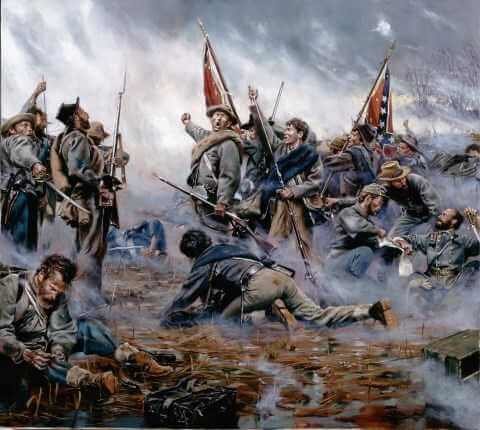
Bonnie Blue Flag by Don Troiani
Mule Shoe, Spotsylvania Court House, May 12, 1864
Mule Shoe, Spotsylvania Court House, May 12, 1864
The “Bloody Angle” at the battle of Spotsylvania on May 12, 1864 was a severe test of Lee’s men against the overwhelming forces of Grant – the latter mounting successive attacks in his war of attrition against Lee’s army. In two weeks of fighting since the start of the Wilderness battles, Grant had already lost 32,000 men to battle as well as 20,000 who reached the end of their enlistments. But more foreign and bounty-enriched recruits would replenish his ranks; despite the continuing heroism of his troops, Lee’s losses were near impossible to repair.
Bernhard Thuersam, www.Circa1865.org The Great American Political Divide
Achieving the Supposed Impossible
“In his extended and penetrating study “Grant’s Campaign of 1864-1865,” (page 285), Major [Charles F.] Atkinson [of the British Army] says truly of the angle:
“The battle is indescribable except by catalog of those deeds of individual heroism that happened to be noted and to be remembered in quieter hours . . . The problem is how to account for Lee’s success and Meade’s failure.” He ascribes it, of course, to “the success of Lee’s men in keeping the battle within the breastworks and to the actual combat of the fight. Lee’s exact knowledge of the tensile strength of his material enabled him to use them to the best possible advantage in succession.”
Comparing their successive hand-to-hand contests with the battles in Greek and Roman warfare, he discusses the psychology of their endurance, the hero’s instinct to fight it out, and the will to win.
He concludes: “All this however does not account for the devotion of the actual combatants. The conditions at the point of contact were certainly such as no man could have endured for long.” He did not know that the South Carolina brigade fought continuously at the point of contact for eighteen hours – achieving the supposed impossible.
Generals Grant, Meade and Wright endeavored all day to reenter the Salient at that “vulnerable” west angle. By defeating them there, Harris’ Mississippi and McGowan’s South Carolina brigades defeated their purpose for the whole battle.
With Lee’s infantry and artillery manning it, the new line was practically impregnable to the Federals. General Barlow, whose division a week later, again led in assault, wrote “On th 18th [of May] we assaulted their second line without success.” This was at 4AM and was a carefully planned combined assault by Hancock’s Second Corps, strengthened by eight thousand fresh troops from Washington.
Wright, Burnside and Warren were to cooperate, but did not attack because the heavy artillery and musketry fire soon drove back Hancok’s troops. “Thus ended the last concerted effort to break up the Confederate lines of defense at Spottsylvania.”
The soldiers who, by their long death struggle made the building of Lee’s new line of breastworks possible, were the South Carolinians who “held the key to the Confederate arch” through the great day of battle – or who died there. There they left their dead and the many wounded unto death. They had not failed. The sacrifice of the heroes in the Bloody Angle line was necessary to save the lives of many others.
General Lee telegraphed to Richmond that after the losses at daybreak “thanks to a merciful Providence our subsequent casualties were not large” – that is, in the army as a whole. At the Bloody Angle, the Mississippi and South Carolina brigades each lost about half their numbers. [The losses elsewhere] would have been great if the soldiers holding the apex-line at the Angle had given way before the new intrenchments were ready.
Upon one brigade depended the fate of the army more than is usual even in battle. They died there that they might save their army. Facing almost certain death, it seemed, for eighteen hours, they and their brigade kept the vastly greater numbers of the enemy who were assaulting them from breaking through to the heart of Lee’s army . . . By their suffering and death many thousands of their comrades were saved.”
(A Colonel at Spottsylvania: The Life and Character of Colonel Joseph Newton Brown, The Battle at Spottsylvania, May 12, 1864, Varina D. Brown, The State Company, 1931, excerpts pp. 300-302)

No comments:
Post a Comment